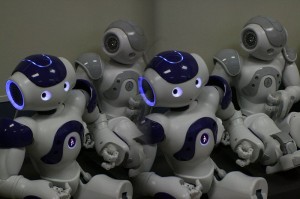Dec 12 2013
Psychologists from the University of Bath are taking part in a major project looking at how cutting-edge robotics can enable people to participate in public spaces, as a place to meet and share ideas without being there in person.
 Nao' will be controlled remotely and used as part of the project to see how cutting edge robotoics can enable people to participate in public spaces.
Nao' will be controlled remotely and used as part of the project to see how cutting edge robotoics can enable people to participate in public spaces.
The £2 million three-year project, Being There: Humans and Robots in Public Spaces, funded by the EPSRC, will examine how robotics can help to bridge the gap between the way we communicate in person and online.
The project brings together researchers from the Universities of Bath, Exeter, Oxford, Queen Mary University of London and the Bristol Robotics Laboratory – a collaborative partnership between the University of the West of England and the University of Bristol - to look at the social and technological aspects of being able to appear in public in proxy forms, via a range of advanced robotics platforms.
Professor Danaë Stanton Fraser said: "We are excited about extending our research in trust and identity to the area of human robot interaction and drawing on our experience of carrying out studies in public spaces".
The research team will create a ‘living laboratory’, using state-of-the-art technologies to measure how people respond to, and interact with other people who are acting through a robot representative.
They will be using an advanced programmable humanoid robot ‘Nao’ that they will take into public spaces around Bath and Bristol to measure human interaction with robots.
Nao will be controlled remotely and its controllers will be able to see and speak through its eyes and mouth, while directing where it looks and walks.
Dr Chris Bevan from the University's Department of Psychology added: “To some degree, the Internet has changed where, when and how strangers meet in public. This has numerous benefits, not least in removing many physical barriers to participation such as geographical distance and infirmity. However, a consequence of digital communication is that much of the richness of real world interpersonal interaction – the source of much of its societal power and benefit – is simply lost in translation.
“By exploring robots as a means of allowing people to ‘be there’ in a real-world public space - regardless of where they actually are - we can bridge the gap between these physical and digital worlds and take full advantage of their respective capabilities”.
Supporting this process, digital creative from Bristol’s iShed will work alongside the researchers, bringing their expertise in public engagement to help bring the research out of the lab and into a range of public spaces in Bristol.
Professor Danaë Stanton Fraser and Dr Chris Bevan will be examining how people, both in front of and behind the robot(s), understand, trust and engage with robotics in real work scenarios. They will be using their complementary expertise in social and cognitive psychology, Human-Computer Interaction (HCI), and robotics to analyse the ways in which people respond to robots.